|
FAQs on Anemone Identification
19
Related Articles: Anemones,
Bubble
Tip Anemones, LTAs, Cnidarians, Coldwater Anemones, Colored/Dyed Anemones,
Related FAQs: Anemone ID 1, Anemone ID 2, Anemone ID 3, Anemone ID 4, Anemone ID 5, Anemone ID 6, Anemone ID 7,
Anemone ID 8,
Anemone ID 9, Anemone ID 10, Anemone ID 11,
Anemone ID 12,
Anemone ID 13, Anemone ID 14, Anemone ID 15, Anemone ID 16, Anemone ID 17, Anemone ID 18, Anemone ID 20, Anemone ID 21, Anemone ID 22, Anemone ID 23, Anemone ID 24, Anemone ID 25, Anemone ID 26, Anemone ID 27, Anemone ID 28, Anemone ID 29, Anemone
ID 30, Anemone ID 31, Anemone ID 32, Anemone ID 33, Anemone ID 34, Anemone ID 35, Anemone ID 36, Anemone ID 37, Anemone ID 38, Anemone ID 39, Anemone ID 40, Anemone ID 41,
Anemone ID 42,
Anemone ID 43,
Anemone ID 44, Anemone ID 45,
& Cnidarian Identification, Anemones 1,
Anemones 2, Anemones 3, Anemones
4, Anemones 5, Invertebrate Identification, Aiptasia
Identification, Aiptasia ID
2, LTA
Identification, Bubble Tip
Anemones, Caribbean
Anemones, Condylactis, Aiptasia
Anemones, Other Pest
Anemones, Anemones and
Clownfishes, Anemone
Reproduction, Anemone
Lighting, Anemone Feeding,
Anemone Systems,
Anemone
Compatibility, Anemone
Selection, Anemone
Health, Anemone Behavior,
Anemone
Placement,
|

|
 |
New Print and
eBook on Amazon:
Anemone Success
Doing what it takes to keep Anemones healthy long-term
by Robert (Bob) Fenner
|
|
Cnidarian id 5/26/17
Hi, Guys! A friend of mine, who's an avid reefer and has been skin diving
for the past 20+yrs, has discovered this rare Cnidarian. It's his first time
encountering this beautiful creature. We think it's an anemone as
the physiology greatly resembles one. The bottom is glued to the
rock like an anemone, not like a soft coral. He collected this off
Negros Island in the Visayas, Philippines, and it's the only one in
the entire area where he dived 2 days ago.
<Ahh>
It's photosensitive as it moved the black ruffle like tentacles when shone
with a flashlight. It has what look like sweeping stinger tentacles buried
underneath the black ruffles. The guy who discovered it, gently poked it
with his chipping hammer to see if it reacted violently, but nothing
happened, so he touched it with his finger and it didn't sting. What do you
guys think it is?
<Does look to be an Actinodendron sp.; have seen a few such possibilities
recently. Often called "Hell fire" anemones> Examples of larger ones here on
WWM:
http://www.wetwebmedia.com/anempt2.htm >
It would be awesome if it's a never before seen species. Hehe.
Hoping for an id,
Paul
<Thank you for sharing. Bob Fenner>
|
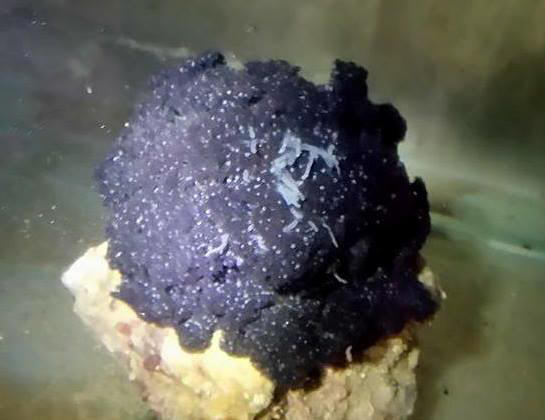 |
|
Anemone ID needed
2/28/15
Hello sir,
Would you kindly indentify the anemone in the attached pic? It has small
tentacles with purple tips.
<Mmm; can't make much out in your pix... Amongst these Zoanthids... does
this "Anemone" have a stony skeleton? Do "give it a gentle poke" to
see/ascertain. If so; it might be a single polyp Caryophylliid or...? If
not, it might be a very stressed Anemonia cf. majano. Please send back
data, and a better resolved pic if you can>
My dad said that you are the best person to ask this question
Thank you.
<Welcome. Bob Fenner> |
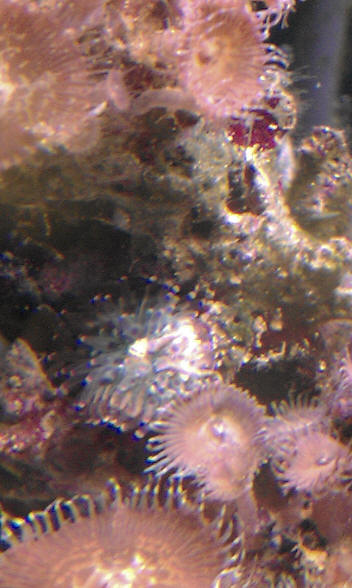 |
| Anemone ID - I've searched the site and
can't find a match 2/27/08 Hi - If you can help that would
be great. I've searched and searched and asked on other forums
and have gotten so many different answers I'm not sure
what's right! My LFS has this anemone and I'm very
interested in it - but want to be sure of its classification before
I buy so that I can ensure giving it proper care. So far I've
heard rock anemone, beaded anemone and H. malu anemone... What do
you think? And if you know - can you also provide a link to where I
can find more information on the species? Thank you! Kim <Hi,
Kim. Mike I with you here. I'm afraid I've given my opinion
on this one already, on a forum (I'm the one who asked if I
could use your pics!). My opinion hasn't changed I'm
afraid, in that it appears to be Heteractis malu. I know you want
more opinions, so hopefully Bob F may chip in as this is published.
All I can add is that if you can manage a picture of the underside
of the oral disc, and anything of the column, it may help seal the
deal. As for more info, searching the WWM files should bring you a
fair bit of information. Thanks. Mike I> |
|
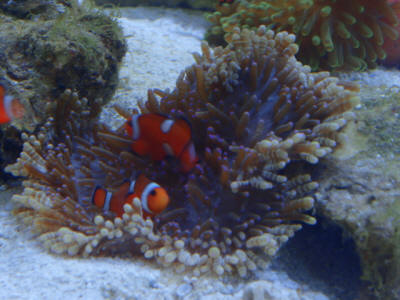 Almost certainly H. malu. RMF Almost certainly H. malu. RMF
|
|
Anemone ID 2/27/08 Hi Guys, <Hi Beta> Let me first
commend you on the great job that the crew is doing. <Thank
you.> I'm looking for an ID on what I think is an anemone
that was sent to me by a friend. These were collected from the
southern part of India but not from a proper reef. It seems to be
motile as in some of them have moved from the original position
that they were in the tank. Can you try IDing this specimen?
<Looks to me like a Majano...Bob?><<I am NOT an
Anemonia! Heeeee! RMF>> Thanks and Regards <You're
welcome. James (Salty Dog)> Beta Chennai, India
Re: Possible ID for this Anemone? 2/27/08 Thanks! Just
to give an idea of the size, the largest one would be 3 inches
across. Regards Beta <Thanks!> ID for this anemone?
2/27/08 Hi Guys, Let me first commend you on the great job
that the crew is doing. I'm looking for an ID on what I think
is an anemone that was sent to me by a friend. These were
collected from the southern part of India but not from a proper
reef. It seems to be motile as in some of them have moved from
the original position that they were in the tank. Can you try
IDing this specimen? Thanks and Regards Beta Chennai, India
<Ahh, very nice. These appear to be Anemonia cf. majano. Bob
Fenner>
Re: ID for this anemone? 2/27/08 Thanks Bob!
<Welcome Beta>
|
|
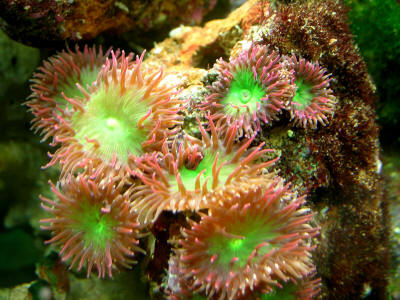
|
Identifying Possible Pest Anemone -- 2/19/08
<Hello> I recently ordered a bag of red algae from my LFS (I
don't know what kind) and found a small anemone attached to a piece
of it. <Uh-oh> I don't know much about anemones (just enough
to say it is one) and I've looked at several pictures but they all
look the same to me! <Heee! Once you look at enough of these things
you'll start to see the differences, especially when it comes to
differentiating the "pests" from the "desirables").
It just takes some experience/research and close observation. For
instance, Aiptasia has slender, pointed tentacles. Not all anemones
have these.> I suppose it looks just like the Aiptasia in shape and
size, (it's small, about 1/3 inch wide) but it is a pale gray
color. I have put it in my quarantine tank and have been feeding it
brine/Mysis pieces until I can find out. Please help! <Hmmm, this is
where a photo would really come in handy. What you have could indeed be
Aiptasia (and likely is!). They're extremely common hitchhikers
that are usually a translucent light to pale brown, although I've
seen darker versions as well as some that were almost colorless.
I've never seen a gray one, but depending on lighting, it's
possible that one could appear so. Also, some species have what appear
to be stripes on the tentacles. What they all have in common is that
they're pests! Please see the photos at these links (as well as
those at the highlighted links above) for comparison:
http://www.wetwebmedia.com/aiptasidfaq2.htm
http://www.wetwebmedia.com/anempt2.htm I'd go on the theory that
'If it walks like a duck and quacks like a duck'¦'
it's a Ummm.. pest anemone and I'd get rid of it! I'd also
check for others as well within the algae. Hope this helps. Please let
me know if you need any additional information or assistance. By the
way, if you're able to get a good photo, I'd be happy to take a
look at it. Take care, -Lynn>
|
ID help Hi <Hi, Mike I with you today> I
was wondering if you could help me ID this anemone.
2/18/08 <Can only try!> I received it from a friend who
was breaking down their tank. Thanks Rich <The animal appears
to be Heteractis magnifica, commonly know as the Magnificent Sea
Anemone. The animal may be slightly bleached. They are
particularly demanding anemones to keep, especially in terms of
lighting and water flow. Do have a read through our anemone
indices here:
http://www.wetwebmedia.com/marine/inverts/cnidaria/anthozoa/anemones.htm
and also more specifically, here:
http://www.wetwebmedia.com/hetmagbehfaqs.htm
|
|
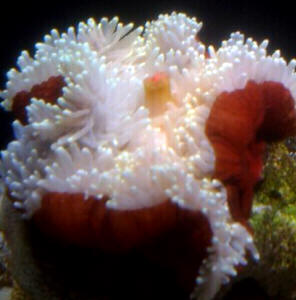 Another ritteri to go. RMF. Another ritteri to go. RMF.
|
| Re: Anemone Identity Unknown? follow
up. 2/8/08 Hey guys thanks for such a quick
response. Great to have someone on here offering their knowledge
because they want to help others. Here is a few more pics. Got one
of the anemones foot, mouth and the whole thing. Once again, thanks
for trying to identify this for me. The lr has been in the tank for
almost 4 years now, I bought the system from a guy about a year
ago, now I am addicted. He said he had an anemone in the tank once
before, he said it spilt once, but then he gave it away, he was not
for sure what kind it was. :( <Looks to me to be an Entacmaea
quadricolor. Please read here: http://wetwebmedia.com/btaidfaqs.htm
and the linked files above. This one's apparently lacking
nutrition, perhaps adequate lighting. Bob Fenner> |
|
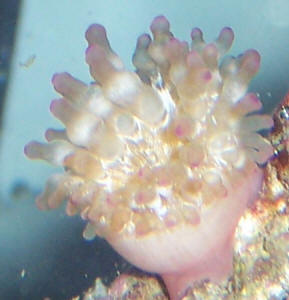
|
| Anemone Identity unknown? -02/06/08 Hey crew.
<Hey!> ran across your website several months ago and I have
read 3/4 of your faq's and guides, most helpful on the net so
far, by far. <Thanks, happy to hear that> I have looked for a
similar anemone picture like this one everywhere, but nothing seems
to be a good match. I was rearranging some LR and discovered him on
the underside of a piece. He is about 1'' width X
1'' tall. <How long has the living rock been in the
tank? Could it have grown from a fragment of a Bubble Tipped
anemone from a different aquarium?> His tips are bubble like so
I believe he may be a some type of BTA. <With something that
size, the dreaded majano anemone could also be in the frame - see
here: http://www.wetwebmedia.com/anemoniafaqs.htm> Here is a
pic. In the close up, the grey spec in the center is a piece of
squid mix the LFS mixes up for a few of us. Also, and how often
should I feed it since it is this small? Got a couple more pics if
you need extra. <Although in the picture it does indeed exhibit
more Bubble Tip qualities than majano, a few more pics would be
helpful - especially of the mouth, and the underside of the
disc> Thanks bunches guys. & gals if applic. <You're
welcome - do come back to us with the required information for a
more informed response. Mike I> |
|

|
 |
New Print and
eBook on Amazon:
Anemone Success
Doing what it takes to keep Anemones healthy long-term
by Robert (Bob) Fenner
|
|
|

